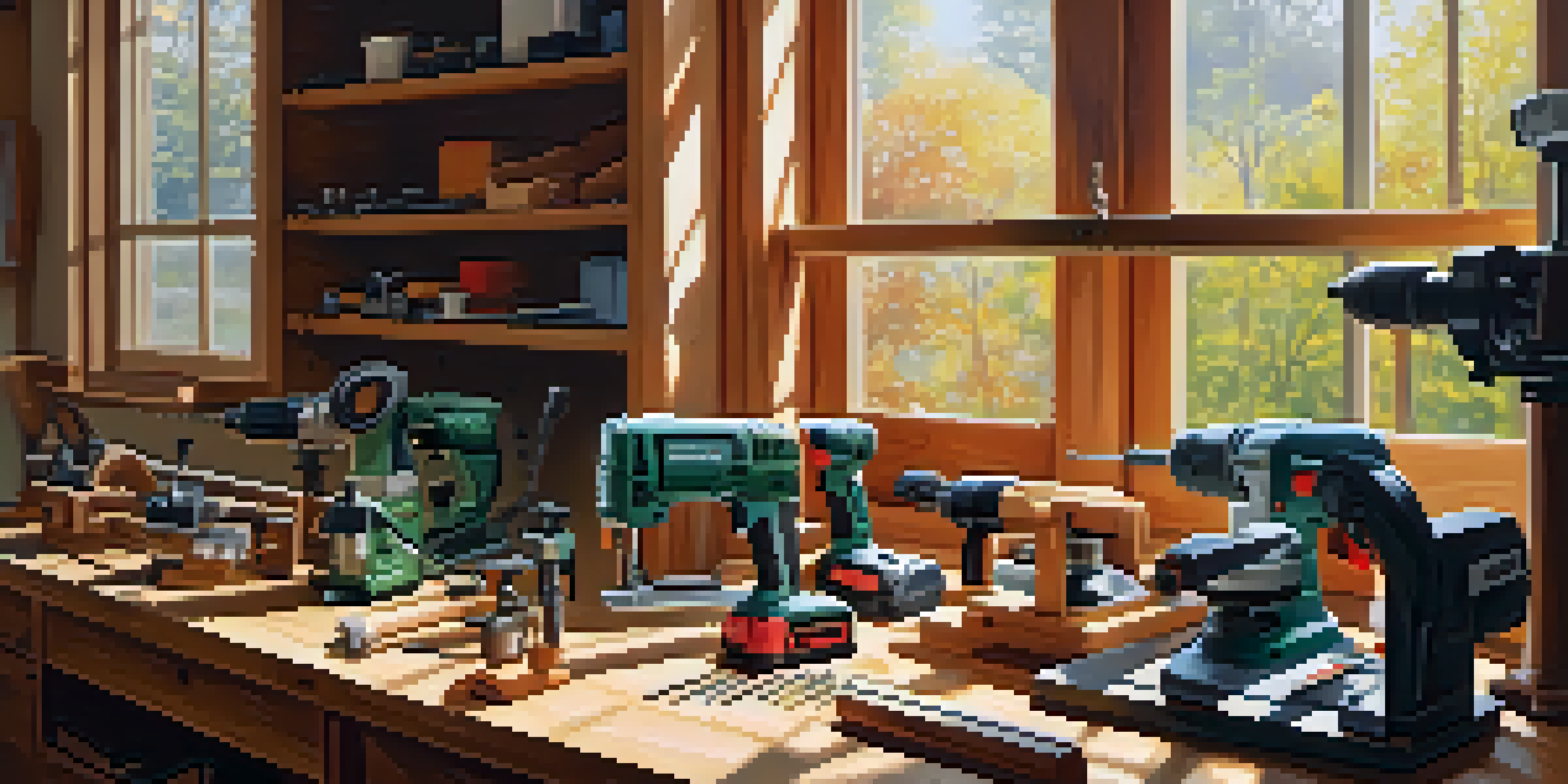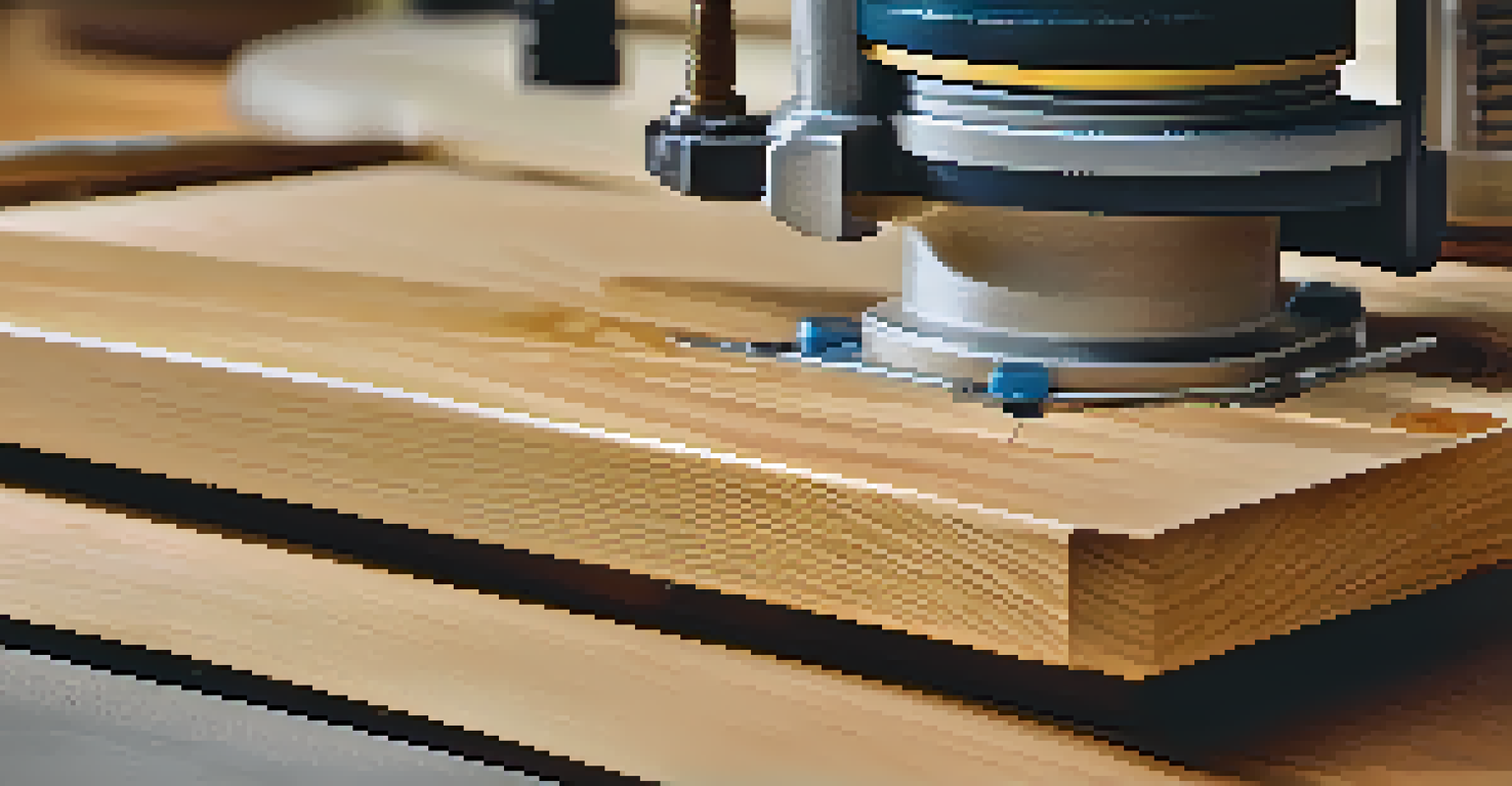Essential Power Tools for Carving: A Comprehensive Overview

Understanding the Basics of Power Tools for Carving
Power tools can be game-changers in the carving world, making intricate designs easier and quicker to achieve. They provide the muscle behind your creativity, allowing you to focus more on the artistry rather than the labor. Understanding the basics of these tools is crucial to selecting the right ones for your projects, whether you're a beginner or a seasoned carver.
The only way to do great work is to love what you do.
Carving involves removing material to create a desired shape or design, and power tools amplify this process. They come in various forms, from rotary tools to chisels, each serving a unique purpose. Knowing how to use them effectively can elevate your work and save you time and effort.
In this overview, we'll dive into the essential power tools every carver should consider. By the end, you'll have a clearer idea of what tools fit your needs and how they can enhance your carving projects.
Rotary Tools: Versatile Powerhouses for Detailed Work
Rotary tools are incredibly versatile, making them a favorite among carvers. These handheld devices can tackle a range of tasks, from grinding and sanding to engraving and polishing. Their adaptability allows you to switch out attachments for various finishes, making them ideal for detailed work on different materials.

One of the most popular rotary tools is the Dremel, known for its ease of use and wide availability of accessories. You can create everything from fine lines to deep grooves, depending on the bit you select. This flexibility is especially beneficial for intricate designs that require precision.
Power Tools Enhance Carving Efficiency
Using power tools allows carvers to focus on artistry while significantly speeding up the material removal process.
Additionally, rotary tools are lightweight and portable, so you can take them to workshops, craft fairs, or even use them at home. With practice, you'll find that these tools can significantly enhance your carving experience, allowing for creativity to flourish without the constraints of manual tools.
Jigsaws: Efficient for Curved Cuts and Patterns
If you're looking to make curved cuts or intricate patterns, a jigsaw is an essential tool to have in your arsenal. Jigsaws are designed to navigate tight curves and can handle various materials, from wood to plastic. This makes them a great option for creating shapes and outlines that other saws might struggle with.
Creativity is intelligence having fun.
Using a jigsaw is straightforward, and once you get the hang of it, you'll appreciate its ability to deliver clean cuts. The blade can be swapped out for different types, allowing you to customize your tool for the material you're working with. This adaptability is key for carvers aiming for precision.
Moreover, jigsaws often come with features like variable speed settings, which can enhance control during cutting. Whether you’re working on a large project or something smaller, a jigsaw can streamline your workflow and help you achieve the desired results smoothly.
Belt Sanders: Perfect for Smooth Surfaces and Shaping
When it comes to achieving smooth finishes, belt sanders are hard to beat. These tools use a continuous loop of sandpaper to quickly remove material and smooth out surfaces, making them ideal for shaping wood before finer detailing is done. They can save you a significant amount of time compared to manual sanding.
Belt sanders come in various sizes, allowing you to choose the right one for your projects. Smaller models are great for detailed work, while larger ones can handle bigger pieces with ease. This versatility allows you to tackle a range of projects, from furniture to intricate carvings.
Versatile Tools for Detailed Work
Rotary tools and jigsaws provide versatility for intricate designs, making them essential for both beginners and experienced carvers.
However, it's essential to use belt sanders with care, as they can remove material quickly. Learning how to control the pressure and movement will help prevent over-sanding and maintain the integrity of your work. With practice, you'll find that these tools can help you achieve professional-quality finishes.
Die Grinders: For Precision and Intricate Designs
Die grinders are another powerful option that excels in precision work. These tools are particularly effective for engraving, shaping, and polishing, making them ideal for detailed carving projects. Their small size and various attachments allow you to navigate tight spaces and intricate designs with ease.
Using a die grinder can feel like wielding a magic wand, as they can transform a rough piece of material into a finely detailed work of art. They come with a variety of bits that can create different textures and finishes, offering endless possibilities for creativity. This makes them a must-have for carvers who love to experiment.
However, like any powerful tool, they require a gentle touch and good technique. Practicing with a die grinder will help you learn how to control the speed and pressure, ensuring your designs come out just as you envision. With time, you'll unlock the full potential of this tool in your carving endeavors.
Wood Routers: Ideal for Edging and Hollowing Out
Wood routers are fantastic for creating decorative edges and hollowing out areas of wood, making them essential for any serious carver. With the right bit, you can create a variety of profiles and shapes, transforming simple pieces into elaborate designs. This makes routers invaluable for both functional and artistic applications.
They come in both fixed and plunge styles, allowing you to choose the right tool based on your project needs. Fixed routers offer stability for consistent cuts, while plunge routers allow for more intricate work, letting you start cuts at any point on the material. This versatility makes them a staple in many workshops.
Safety is Key with Power Tools
Prioritizing safety measures, such as using protective gear and maintaining a clean workspace, is crucial for a successful carving experience.
While routers can be intimidating at first, they can yield impressive results with practice. Learning how to control the speed and depth of your cuts will empower you to create stunning details in your carvings. Soon, you'll be routing like a pro, adding depth and character to your projects effortlessly.
Chisels and Power Carving Tools: The Perfect Pair
While power tools are fantastic, traditional chisels still play an important role in carving. They offer a level of control and finesse that can sometimes be lost with power tools. Pairing chisels with power carving tools creates a dynamic duo that allows carvers to achieve both speed and precision in their work.
Power carving tools, like the Foredom rotary tool, are designed specifically for detailed work and can be used with various chisels. This combination allows you to take advantage of the speed of power tools while still maintaining the artistry that comes with hand-carving. It’s an efficient way to merge traditional techniques with modern technology.

Ultimately, the choice between power tools and chisels comes down to personal preference and the specific requirements of each project. By experimenting with both, you'll discover what works best for you and how to create stunning carvings that showcase your unique style.
Safety Tips: Carving with Power Tools Responsibly
Safety should always be a priority when working with power tools. Each tool comes with its own set of risks, so understanding how to use them properly is crucial. From wearing protective eyewear to using dust masks, taking precautions can prevent accidents and ensure a safe working environment.
Make sure to read the user manuals for each power tool, as they contain essential information about safe operation. Additionally, maintaining a clean workspace can help prevent injuries caused by slipping or tripping over tools and materials. A tidy area promotes focus and minimizes distractions.
Lastly, don't hesitate to invest in high-quality safety gear, including gloves and hearing protection, especially when using louder tools. By prioritizing safety, you'll foster a more enjoyable and productive carving experience. Remember, a safe carver is a happy carver!